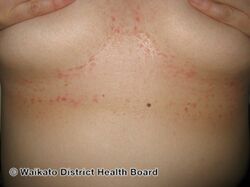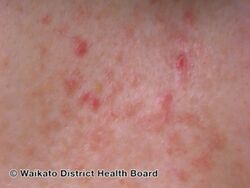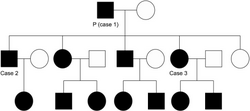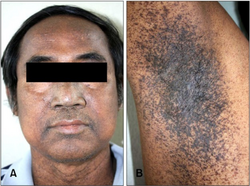Dowling–Degos disease
| Dowling–Degos disease | |
|---|---|
| Other names: Reticular pigmented anomaly of the flexures[1] | |
 | |
| Specialty | Dermatology |
| Symptoms | Lace-like darkening in skin folds[1] |
| Usual onset | After puberty[1] |
| Diagnostic method | Visualisation, skin biopsy[2] |
| Differential diagnosis | Reticulate acropigmentation of Kitamura, Haber syndrome, neurofibromatosis type 1, acanthosis nigricans[2] |
| Frequency | Rare, <50 cases worldwide (as of 2022)[2] |
| Deaths | None[2] |
Dowling–Degos disease (DDD), is a type of reticulate pigmentary disorder of the skin.[1] It presents with small dark spots and bumps that form a lace-like pattern in skin folds such as underarms, neck, under breasts, and genital areas.[2] The condition may result in psychological stress.[2]
It runs in families and generally appears in adolescence, although may present in later adulthood.[1] It is due to mutations in structural/desmosomal proteins found within stratified squamous epithelium.[3] DDD is associated with KRT5.[4] Diagnosis is by visualisation and skin biopsy.[2] It may appear similar to reticulate acropigmentation of Kitamura, Haber syndrome, neurofibromatosis type 1, and acanthosis nigricans.[2]
Treatments tried include applying hydroquinone, tretinoin, adapalene, and corticosteroids, but are generally unsuccessful.[2] Applying corticosteroids and fusidic acid after Er:YAG laser has been reported to be successful in some reports.[2]
It is rare.[2] Since the first report in 1938, there have been less than 50 cases described.[2]
Signs and symptoms
-
Dowling-Degos disease
-
Dowling-Degos disease
Genetics
-
Pedigree of family with generalized Dowling-Degos disease (DDD). Father (P), first son (case 2), and second daughter (case 3) with DDD
-
82-year-old father with Dowling-Degos disease
-
58-year-old son with Dowling-Degos disease
-
50-year-old daughter with Dowling-Degos disease
Diagnosis
-
Skin biopsy
See also
References
- ↑ 1.0 1.1 1.2 1.3 1.4 James, William D.; Elston, Dirk; Treat, James R.; Rosenbach, Misha A.; Neuhaus, Isaac (2020). "36. Disturbances of pigmentation: Dowling–Degos disease". Andrews' Diseases of the Skin: Clinical Dermatology (13th ed.). Edinburgh: Elsevier. p. 866. ISBN 978-0-323-54753-6. Archived from the original on 2023-06-30. Retrieved 2023-05-05.
- ↑ 2.00 2.01 2.02 2.03 2.04 2.05 2.06 2.07 2.08 2.09 2.10 2.11 Rice, Ashley S.; Cook, Christopher (2023). "Dowling Degos Disease". StatPearls. StatPearls Publishing. PMID 30285365. Archived from the original on 2021-04-03. Retrieved 2023-05-05.
- ↑ Rapini, Ronald P.; Bolognia, Jean L.; Jorizzo, Joseph L. (2007). Dermatology: 2-Volume Set. St. Louis: Mosby. ISBN 978-1-4160-2999-1.
- ↑ Adya, Keshavmurthy A; Inamadar, Arun C; Palit, Aparna (2014). "Reticulate Dermatoses". Indian Journal of Dermatology. 59 (1): 3–14. doi:10.4103/0019-5154.123480. ISSN 0019-5154. PMID 24470653. Archived from the original on 2022-08-17. Retrieved 2023-05-05.
External links
| Classification |
|---|






